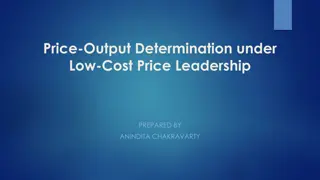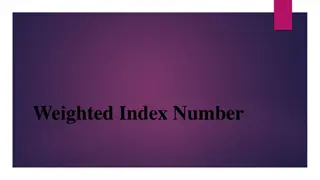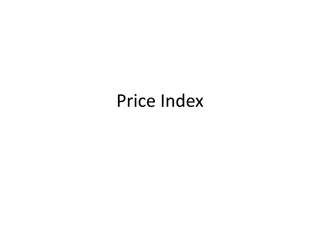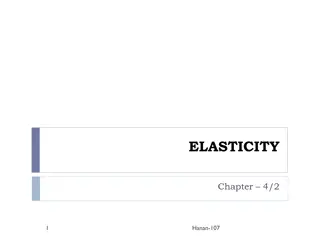
The Hidden Price Tag Unveiling the Financial Risks of Fast Fashion
Fast fashion has revolutionized the clothing industry, offering trendy styles at rock-bottom prices. But this seemingly endless stream of affordable apparel comes with a hidden cost, impacting not just your wallet but also the environment and society
Download Presentation

Please find below an Image/Link to download the presentation.
The content on the website is provided AS IS for your information and personal use only. It may not be sold, licensed, or shared on other websites without obtaining consent from the author. Download presentation by click this link. If you encounter any issues during the download, it is possible that the publisher has removed the file from their server.
E N D
Presentation Transcript
The Hidden Price Tag: Unveiling the Financial Risks of Fast Fashion Fast fashion has revolutionized the clothing industry, offering trendy styles at rock-bottom prices. But this seemingly endless stream of affordable apparel comes with a hidden cost, impacting not just your wallet but also the environment and society at large. This article delves into the financial risks associated with fast fashion, urging you to consider the true cost of your clothing choices. The Allure of Affordability: A Double-Edged Sword
Fast fashion thrives on the concept of "disposable clothing." New collections arrive weekly, enticing consumers with trendy pieces at prices so low they seem like steals. This affordability, however, creates an illusion. Here's why: Impulse Purchases: The constant influx of trendy items fuels impulsive buying. You might snag a cute top "just because" without considering if it truly complements your wardrobe or how often you'll wear it. These impulse purchases accumulate, leading to wardrobe clutter and wasted money. Poor Quality: Fast fashion prioritizes speed and low costs over quality. Clothes are often made with cheap, synthetic materials that are prone to shrinking, fading, and tearing quickly. This means you'll likely need to replace them sooner, negating the initial savings. Quantity over Quality: The allure of having several trendy pieces often overshadows the need for well-made staples. Fast fashion might tempt you to buy multiple low-quality items instead of investing in a single, high- quality piece that will last longer. The Vicious Cycle of Trends: Fast fashion thrives on the rapid churn of trends. New styles are constantly pushed, creating a sense of urgency to keep up. This fuels a cycle of overconsumption, as consumers feel pressured to constantly update their wardrobes. The financial burden of keeping up with trends can be significant, especially for budget-conscious shoppers. Beyond the Individual: The Financial Risks to the Global Economy
The financial repercussions of fast fashion extend far beyond the individual consumer. Here's how it impacts the global economy: Exploitative Labor Practices: To maintain low prices, fast fashion brands often rely on cheap labor in developing countries. This translates to poor working conditions, low wages, and potential human rights violations. Environmental Costs: The fast fashion industry has a massive environmental footprint. From excessive water usage in production to textile waste filling landfills, the financial burden of environmental damage falls back on society. Job Losses in Developed Economies: The reliance on cheap overseas labor leads to job losses in the textile and garment industries of developed countries. This disrupts local economies and increases unemployment rates.
Economic Instability: The fast fashion business model prioritizes short-term profits over long-term sustainability. This approach can lead to economic instability and boom-and-bust cycles in the industry. Investing in a Sustainable Future: Alternatives to Fast Fashion Fortunately, there are ways to break free from the financial trap of fast fashion and invest in a more sustainable future: Embrace Minimalism: Focus on building a capsule wardrobe with high-quality, timeless pieces that can be mixed and matched. Shop Secondhand: Explore thrift stores, vintage shops, and online marketplaces for unique and affordable clothing options.
Invest in Quality: Buy fewer, well-made clothes from brands that prioritize ethical production and sustainable practices. Support Local Designers: Opt for locally-made clothes that often offer higher quality, unique designs, and contribute to your local economy. Embrace Clothing Swaps: Organize or participate in clothing swaps with friends to refresh your wardrobe without spending a dime. By making conscious choices and embracing alternatives, you can avoid the financial risks of fast fashion and contribute to a more sustainable and equitable future for the global economy. Conclusion: Fashion with a Conscience Fast fashion might seem like a budget-friendly option, but the hidden costs are significant. By understanding the financial risks of fast fashion and adopting sustainable shopping practices, you can not only save money but also contribute to a more ethical and environmentally responsible fashion industry. Remember, true style comes from conscious choices and timeless pieces you'll cherish for years to come.






















